CHRYSLER VOYAGER 1996 Service Manual
Manufacturer: CHRYSLER, Model Year: 1996, Model line: VOYAGER, Model: CHRYSLER VOYAGER 1996Pages: 1938, PDF Size: 55.84 MB
Page 1651 of 1938
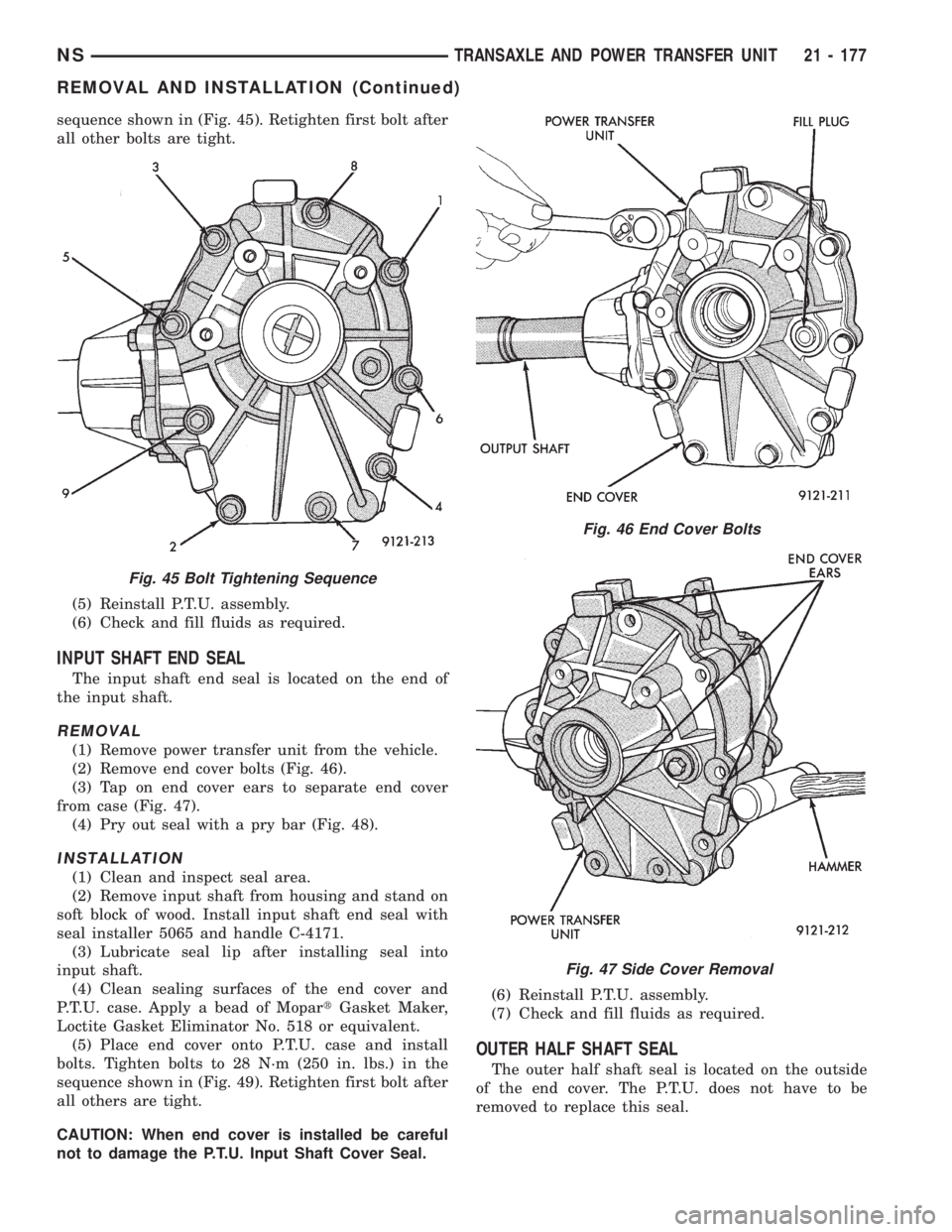
sequence shown in (Fig. 45). Retighten first bolt after
all other bolts are tight.
(5) Reinstall P.T.U. assembly.
(6) Check and fill fluids as required.
INPUT SHAFT END SEAL
The input shaft end seal is located on the end of
the input shaft.
REMOVAL
(1) Remove power transfer unit from the vehicle.
(2) Remove end cover bolts (Fig. 46).
(3) Tap on end cover ears to separate end cover
from case (Fig. 47).
(4) Pry out seal with a pry bar (Fig. 48).
INSTALLATION
(1) Clean and inspect seal area.
(2) Remove input shaft from housing and stand on
soft block of wood. Install input shaft end seal with
seal installer 5065 and handle C-4171.
(3) Lubricate seal lip after installing seal into
input shaft.
(4) Clean sealing surfaces of the end cover and
P.T.U. case. Apply a bead of MopartGasket Maker,
Loctite Gasket Eliminator No. 518 or equivalent.
(5) Place end cover onto P.T.U. case and install
bolts. Tighten bolts to 28 N´m (250 in. lbs.) in the
sequence shown in (Fig. 49). Retighten first bolt after
all others are tight.
CAUTION: When end cover is installed be careful
not to damage the P.T.U. Input Shaft Cover Seal.(6) Reinstall P.T.U. assembly.
(7) Check and fill fluids as required.
OUTER HALF SHAFT SEAL
The outer half shaft seal is located on the outside
of the end cover. The P.T.U. does not have to be
removed to replace this seal.
Fig. 45 Bolt Tightening Sequence
Fig. 46 End Cover Bolts
Fig. 47 Side Cover Removal
NSTRANSAXLE AND POWER TRANSFER UNIT 21 - 177
REMOVAL AND INSTALLATION (Continued)
Page 1652 of 1938
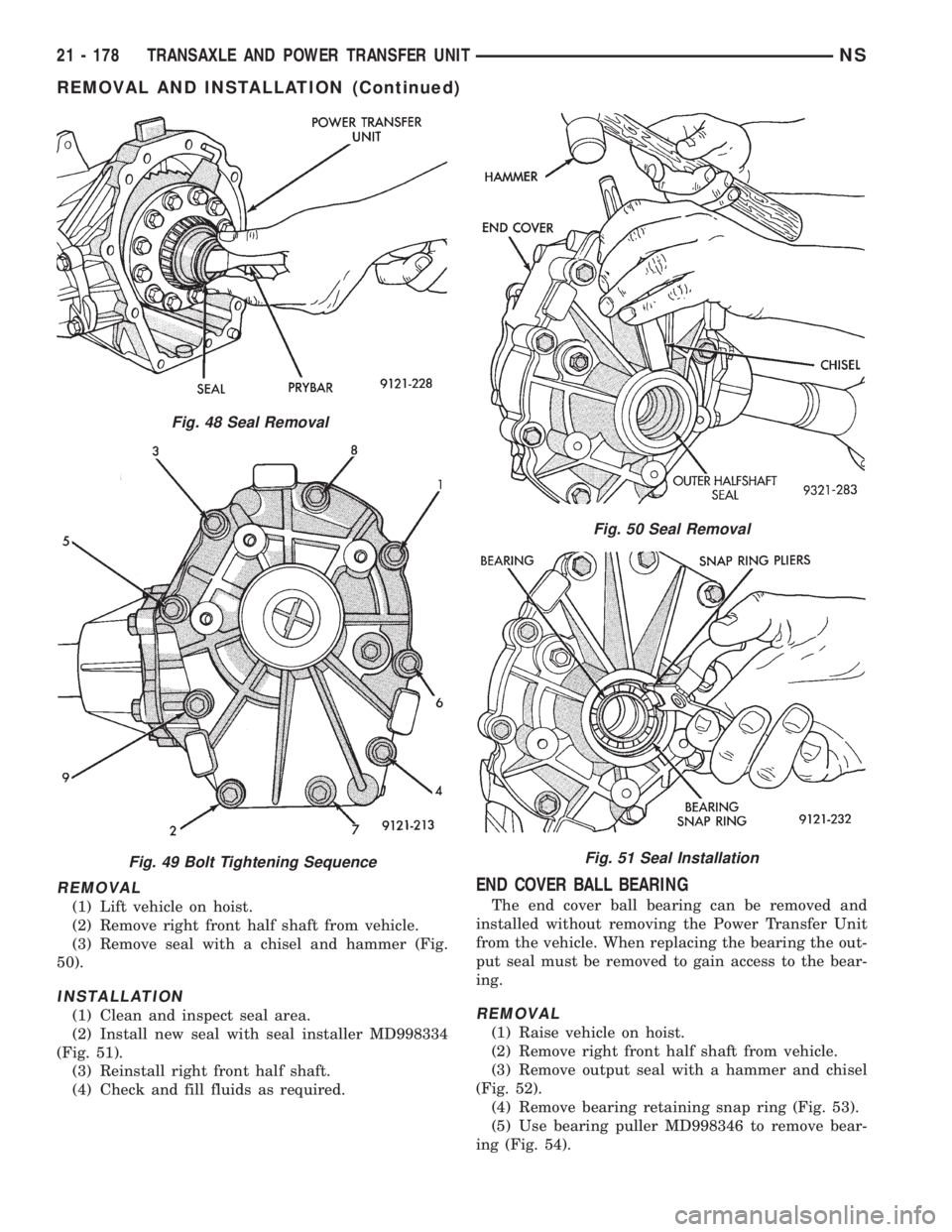
REMOVAL
(1) Lift vehicle on hoist.
(2) Remove right front half shaft from vehicle.
(3) Remove seal with a chisel and hammer (Fig.
50).
INSTALLATION
(1) Clean and inspect seal area.
(2) Install new seal with seal installer MD998334
(Fig. 51).
(3) Reinstall right front half shaft.
(4) Check and fill fluids as required.
END COVER BALL BEARING
The end cover ball bearing can be removed and
installed without removing the Power Transfer Unit
from the vehicle. When replacing the bearing the out-
put seal must be removed to gain access to the bear-
ing.
REMOVAL
(1) Raise vehicle on hoist.
(2) Remove right front half shaft from vehicle.
(3) Remove output seal with a hammer and chisel
(Fig. 52).
(4) Remove bearing retaining snap ring (Fig. 53).
(5) Use bearing puller MD998346 to remove bear-
ing (Fig. 54).
Fig. 48 Seal Removal
Fig. 49 Bolt Tightening Sequence
Fig. 50 Seal Removal
Fig. 51 Seal Installation
21 - 178 TRANSAXLE AND POWER TRANSFER UNITNS
REMOVAL AND INSTALLATION (Continued)
Page 1653 of 1938
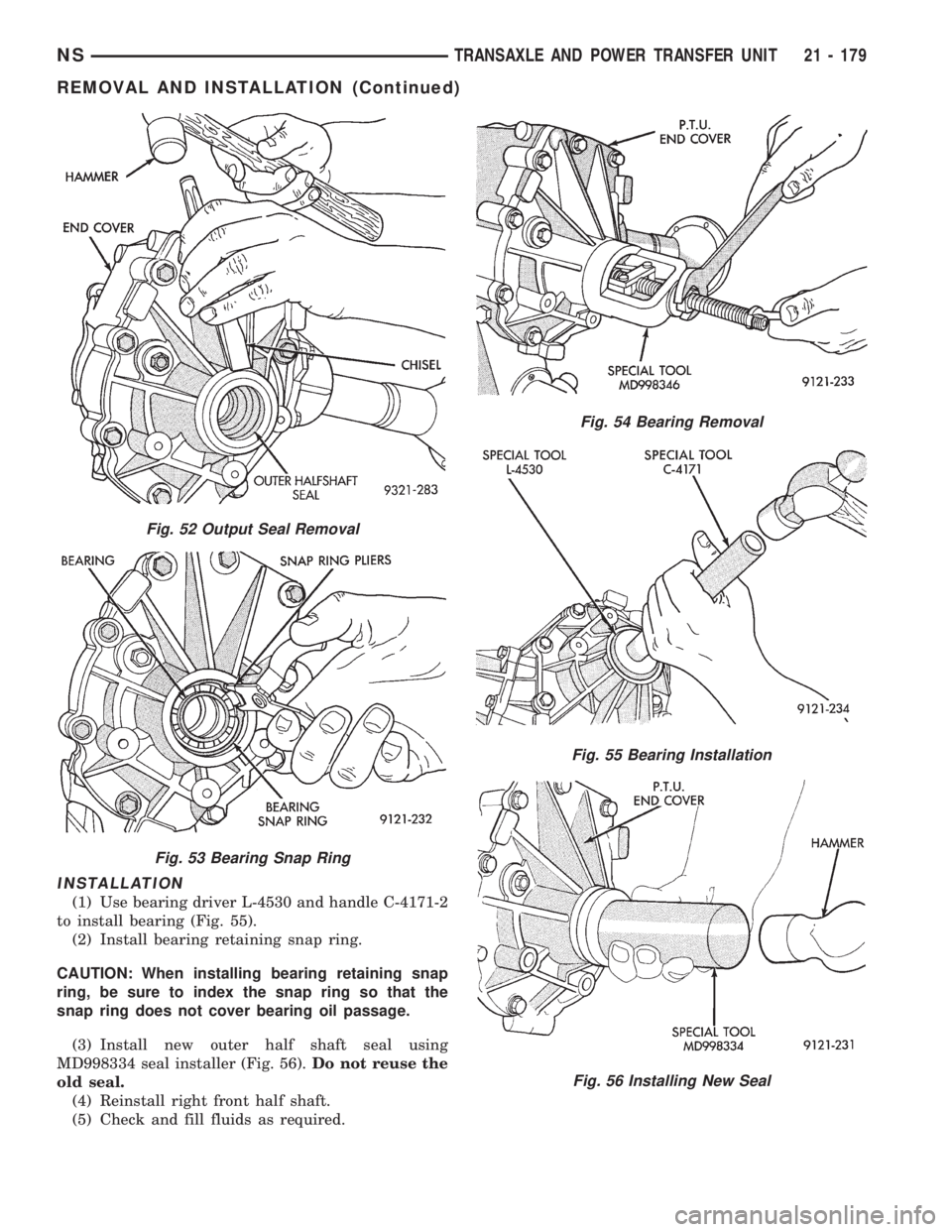
INSTALLATION
(1) Use bearing driver L-4530 and handle C-4171-2
to install bearing (Fig. 55).
(2) Install bearing retaining snap ring.
CAUTION: When installing bearing retaining snap
ring, be sure to index the snap ring so that the
snap ring does not cover bearing oil passage.
(3) Install new outer half shaft seal using
MD998334 seal installer (Fig. 56).Do not reuse the
old seal.
(4) Reinstall right front half shaft.
(5) Check and fill fluids as required.
Fig. 52 Output Seal Removal
Fig. 53 Bearing Snap Ring
Fig. 54 Bearing Removal
Fig. 55 Bearing Installation
Fig. 56 Installing New Seal
NSTRANSAXLE AND POWER TRANSFER UNIT 21 - 179
REMOVAL AND INSTALLATION (Continued)
Page 1654 of 1938
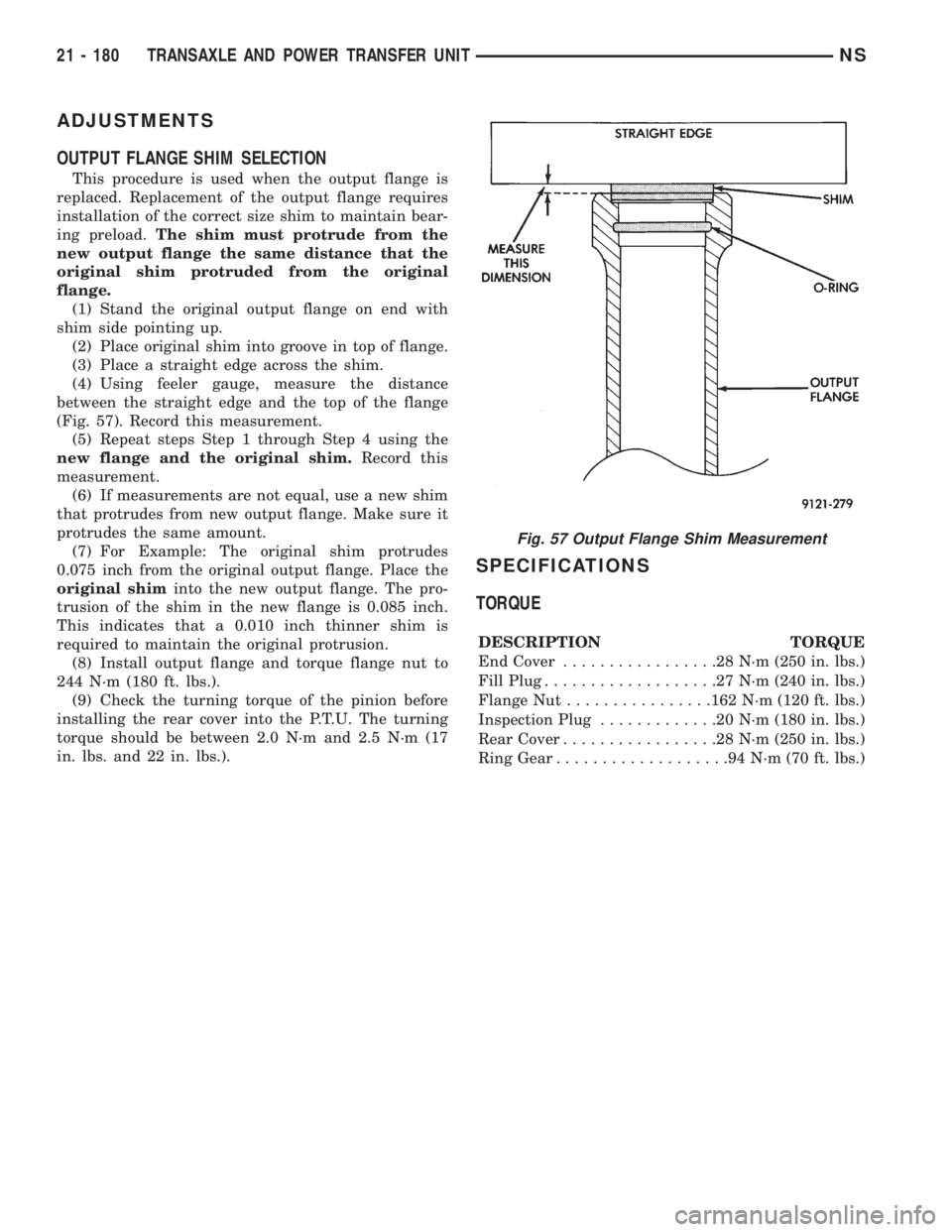
ADJUSTMENTS
OUTPUT FLANGE SHIM SELECTION
This procedure is used when the output flange is
replaced. Replacement of the output flange requires
installation of the correct size shim to maintain bear-
ing preload.The shim must protrude from the
new output flange the same distance that the
original shim protruded from the original
flange.
(1) Stand the original output flange on end with
shim side pointing up.
(2) Place original shim into groove in top of flange.
(3) Place a straight edge across the shim.
(4) Using feeler gauge, measure the distance
between the straight edge and the top of the flange
(Fig. 57). Record this measurement.
(5) Repeat steps Step 1 through Step 4 using the
new flange and the original shim.Record this
measurement.
(6) If measurements are not equal, use a new shim
that protrudes from new output flange. Make sure it
protrudes the same amount.
(7) For Example: The original shim protrudes
0.075 inch from the original output flange. Place the
original shiminto the new output flange. The pro-
trusion of the shim in the new flange is 0.085 inch.
This indicates that a 0.010 inch thinner shim is
required to maintain the original protrusion.
(8) Install output flange and torque flange nut to
244 N´m (180 ft. lbs.).
(9) Check the turning torque of the pinion before
installing the rear cover into the P.T.U. The turning
torque should be between 2.0 N´m and 2.5 N´m (17
in. lbs. and 22 in. lbs.).
SPECIFICATIONS
TORQUE
DESCRIPTION TORQUE
End Cover.................28N´m(250 in. lbs.)
Fill Plug...................27N´m(240 in. lbs.)
Flange Nut................162 N´m (120 ft. lbs.)
Inspection Plug.............20N´m(180 in. lbs.)
Rear Cover.................28N´m(250 in. lbs.)
Ring Gear...................94N´m(70ft.lbs.)
Fig. 57 Output Flange Shim Measurement
21 - 180 TRANSAXLE AND POWER TRANSFER UNITNS
Page 1655 of 1938
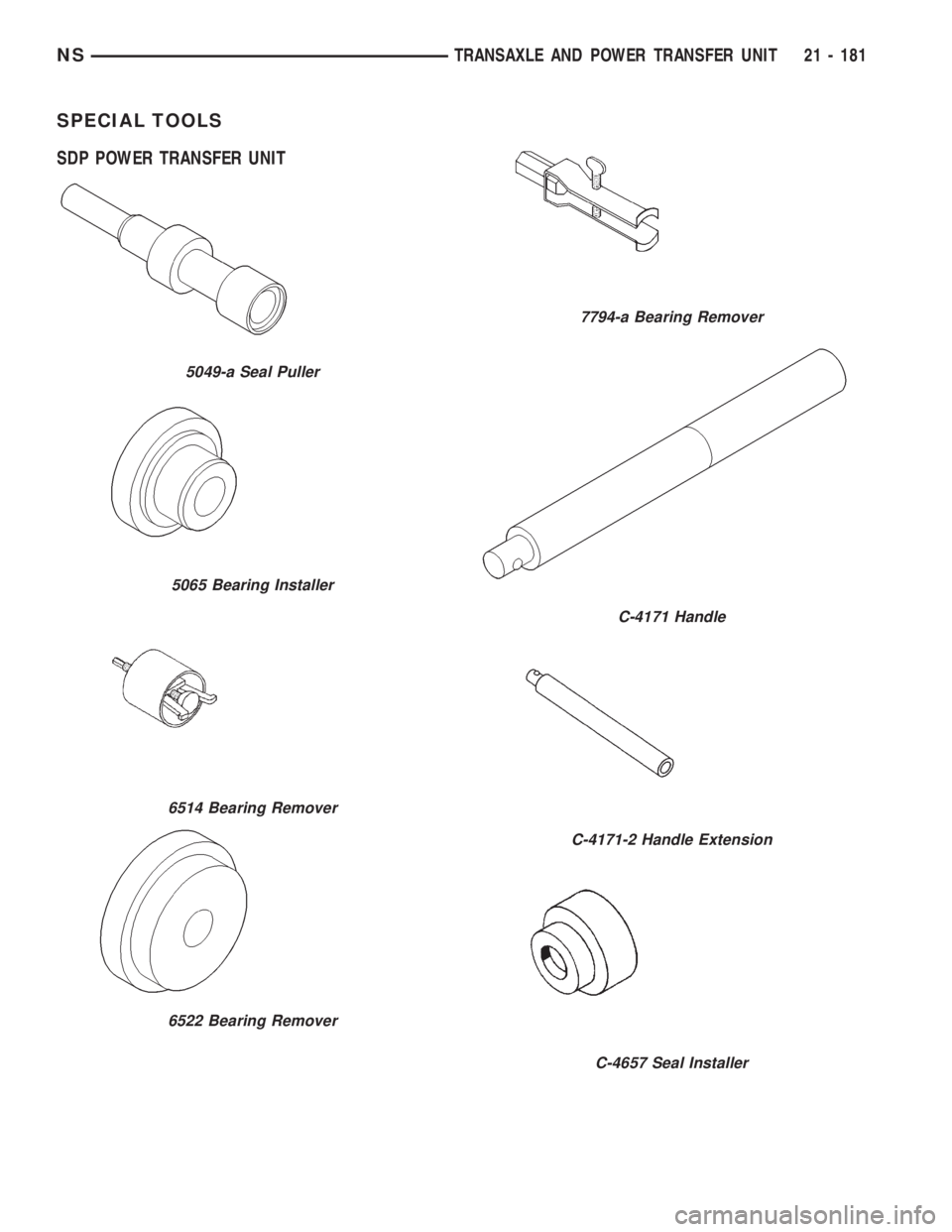
SPECIAL TOOLS
SDP POWER TRANSFER UNIT
5049-a Seal Puller
5065 Bearing Installer
6514 Bearing Remover
6522 Bearing Remover
7794-a Bearing Remover
C-4171 Handle
C-4171-2 Handle Extension
C-4657 Seal Installer
NSTRANSAXLE AND POWER TRANSFER UNIT 21 - 181
Page 1656 of 1938

Page 1657 of 1938
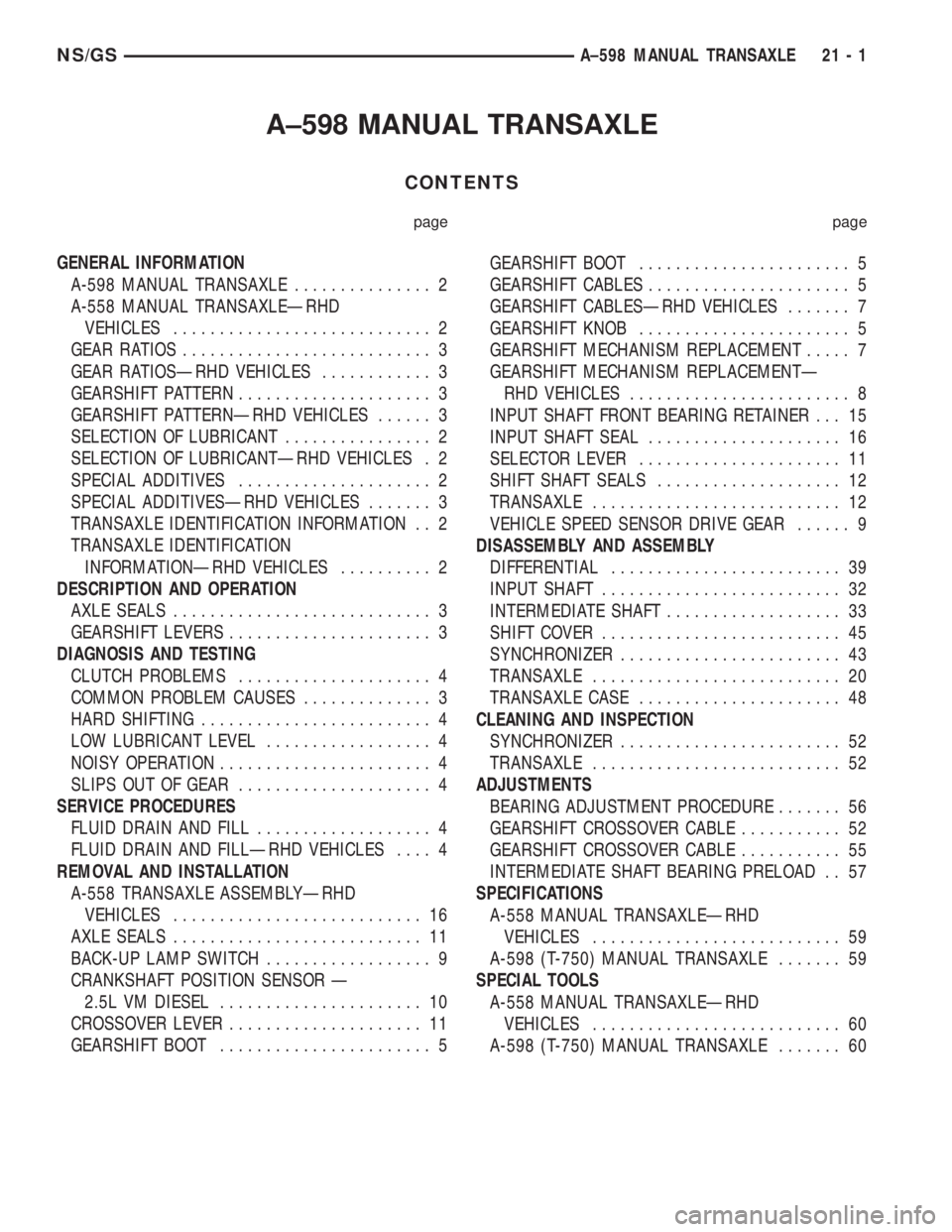
A±598 MANUAL TRANSAXLE
CONTENTS
page page
GENERAL INFORMATION
A-598 MANUAL TRANSAXLE............... 2
A-558 MANUAL TRANSAXLEÐRHD
VEHICLES............................ 2
GEAR RATIOS........................... 3
GEAR RATIOSÐRHD VEHICLES............ 3
GEARSHIFT PATTERN..................... 3
GEARSHIFT PATTERNÐRHD VEHICLES...... 3
SELECTION OF LUBRICANT................ 2
SELECTION OF LUBRICANTÐRHD VEHICLES . 2
SPECIAL ADDITIVES..................... 2
SPECIAL ADDITIVESÐRHD VEHICLES....... 3
TRANSAXLE IDENTIFICATION INFORMATION . . 2
TRANSAXLE IDENTIFICATION
INFORMATIONÐRHD VEHICLES.......... 2
DESCRIPTION AND OPERATION
AXLE SEALS............................ 3
GEARSHIFT LEVERS...................... 3
DIAGNOSIS AND TESTING
CLUTCH PROBLEMS..................... 4
COMMON PROBLEM CAUSES.............. 3
HARD SHIFTING......................... 4
LOW LUBRICANT LEVEL.................. 4
NOISY OPERATION....................... 4
SLIPS OUT OF GEAR..................... 4
SERVICE PROCEDURES
FLUID DRAIN AND FILL................... 4
FLUID DRAIN AND FILLÐRHD VEHICLES.... 4
REMOVAL AND INSTALLATION
A-558 TRANSAXLE ASSEMBLYÐRHD
VEHICLES........................... 16
AXLE SEALS........................... 11
BACK-UP LAMP SWITCH.................. 9
CRANKSHAFT POSITION SENSOR Ð
2.5L VM DIESEL...................... 10
CROSSOVER LEVER..................... 11
GEARSHIFT BOOT....................... 5GEARSHIFT BOOT....................... 5
GEARSHIFT CABLES...................... 5
GEARSHIFT CABLESÐRHD VEHICLES....... 7
GEARSHIFT KNOB....................... 5
GEARSHIFT MECHANISM REPLACEMENT..... 7
GEARSHIFT MECHANISM REPLACEMENTÐ
RHD VEHICLES........................ 8
INPUT SHAFT FRONT BEARING RETAINER . . . 15
INPUT SHAFT SEAL..................... 16
SELECTOR LEVER...................... 11
SHIFT SHAFT SEALS.................... 12
TRANSAXLE........................... 12
VEHICLE SPEED SENSOR DRIVE GEAR...... 9
DISASSEMBLY AND ASSEMBLY
DIFFERENTIAL......................... 39
INPUT SHAFT.......................... 32
INTERMEDIATE SHAFT................... 33
SHIFT COVER.......................... 45
SYNCHRONIZER........................ 43
TRANSAXLE........................... 20
TRANSAXLE CASE...................... 48
CLEANING AND INSPECTION
SYNCHRONIZER........................ 52
TRANSAXLE........................... 52
ADJUSTMENTS
BEARING ADJUSTMENT PROCEDURE....... 56
GEARSHIFT CROSSOVER CABLE........... 52
GEARSHIFT CROSSOVER CABLE........... 55
INTERMEDIATE SHAFT BEARING PRELOAD . . 57
SPECIFICATIONS
A-558 MANUAL TRANSAXLEÐRHD
VEHICLES........................... 59
A-598 (T-750) MANUAL TRANSAXLE....... 59
SPECIAL TOOLS
A-558 MANUAL TRANSAXLEÐRHD
VEHICLES........................... 60
A-598 (T-750) MANUAL TRANSAXLE....... 60
NS/GSA±598 MANUAL TRANSAXLE 21 - 1
Page 1658 of 1938
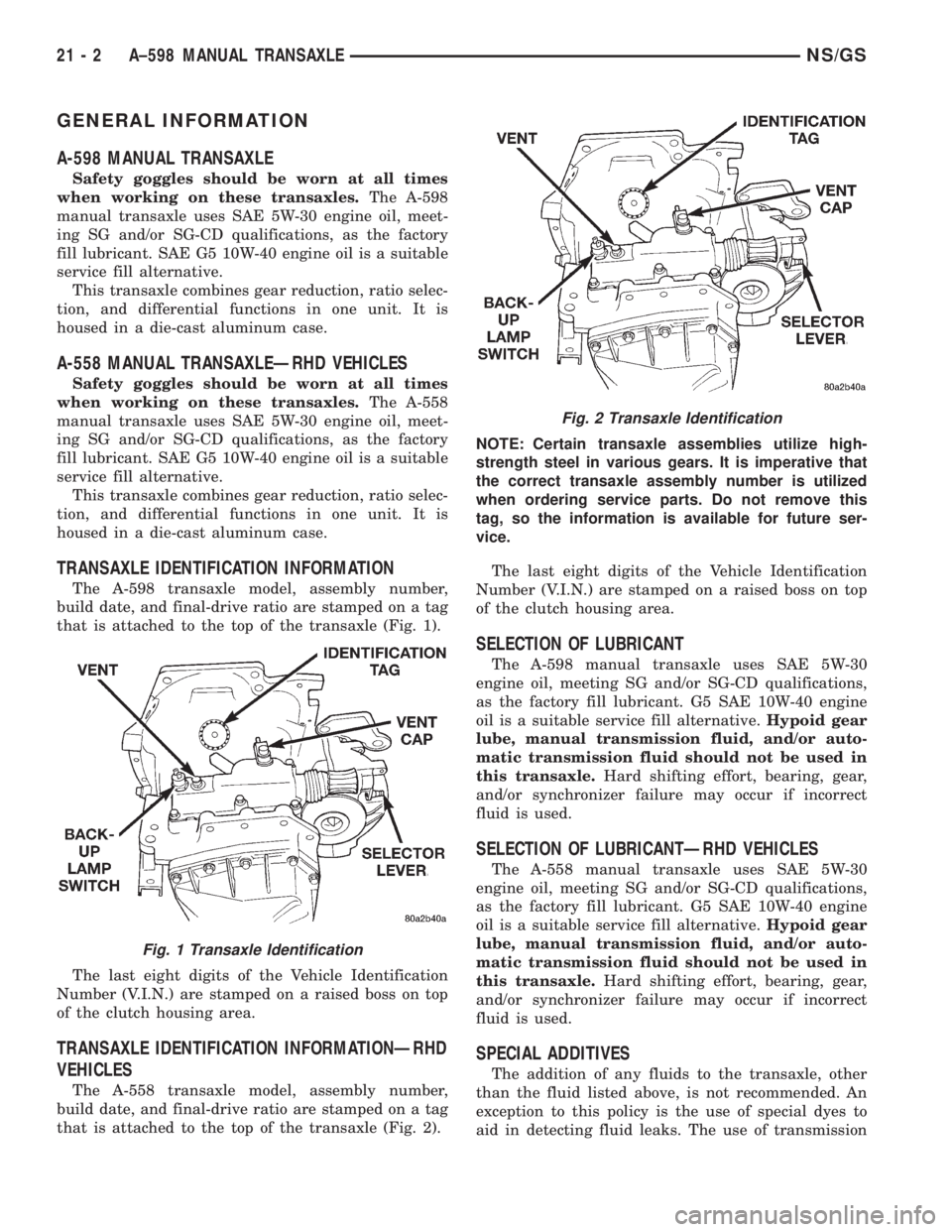
GENERAL INFORMATION
A-598 MANUAL TRANSAXLE
Safety goggles should be worn at all times
when working on these transaxles.The A-598
manual transaxle uses SAE 5W-30 engine oil, meet-
ing SG and/or SG-CD qualifications, as the factory
fill lubricant. SAE G5 10W-40 engine oil is a suitable
service fill alternative.
This transaxle combines gear reduction, ratio selec-
tion, and differential functions in one unit. It is
housed in a die-cast aluminum case.
A-558 MANUAL TRANSAXLEÐRHD VEHICLES
Safety goggles should be worn at all times
when working on these transaxles.The A-558
manual transaxle uses SAE 5W-30 engine oil, meet-
ing SG and/or SG-CD qualifications, as the factory
fill lubricant. SAE G5 10W-40 engine oil is a suitable
service fill alternative.
This transaxle combines gear reduction, ratio selec-
tion, and differential functions in one unit. It is
housed in a die-cast aluminum case.
TRANSAXLE IDENTIFICATION INFORMATION
The A-598 transaxle model, assembly number,
build date, and final-drive ratio are stamped on a tag
that is attached to the top of the transaxle (Fig. 1).
The last eight digits of the Vehicle Identification
Number (V.I.N.) are stamped on a raised boss on top
of the clutch housing area.
TRANSAXLE IDENTIFICATION INFORMATIONÐRHD
VEHICLES
The A-558 transaxle model, assembly number,
build date, and final-drive ratio are stamped on a tag
that is attached to the top of the transaxle (Fig. 2).NOTE: Certain transaxle assemblies utilize high-
strength steel in various gears. It is imperative that
the correct transaxle assembly number is utilized
when ordering service parts. Do not remove this
tag, so the information is available for future ser-
vice.
The last eight digits of the Vehicle Identification
Number (V.I.N.) are stamped on a raised boss on top
of the clutch housing area.
SELECTION OF LUBRICANT
The A-598 manual transaxle uses SAE 5W-30
engine oil, meeting SG and/or SG-CD qualifications,
as the factory fill lubricant. G5 SAE 10W-40 engine
oil is a suitable service fill alternative.Hypoid gear
lube, manual transmission fluid, and/or auto-
matic transmission fluid should not be used in
this transaxle.Hard shifting effort, bearing, gear,
and/or synchronizer failure may occur if incorrect
fluid is used.
SELECTION OF LUBRICANTÐRHD VEHICLES
The A-558 manual transaxle uses SAE 5W-30
engine oil, meeting SG and/or SG-CD qualifications,
as the factory fill lubricant. G5 SAE 10W-40 engine
oil is a suitable service fill alternative.Hypoid gear
lube, manual transmission fluid, and/or auto-
matic transmission fluid should not be used in
this transaxle.Hard shifting effort, bearing, gear,
and/or synchronizer failure may occur if incorrect
fluid is used.
SPECIAL ADDITIVES
The addition of any fluids to the transaxle, other
than the fluid listed above, is not recommended. An
exception to this policy is the use of special dyes to
aid in detecting fluid leaks. The use of transmission
Fig. 1 Transaxle Identification
Fig. 2 Transaxle Identification
21 - 2 A±598 MANUAL TRANSAXLENS/GS
Page 1659 of 1938
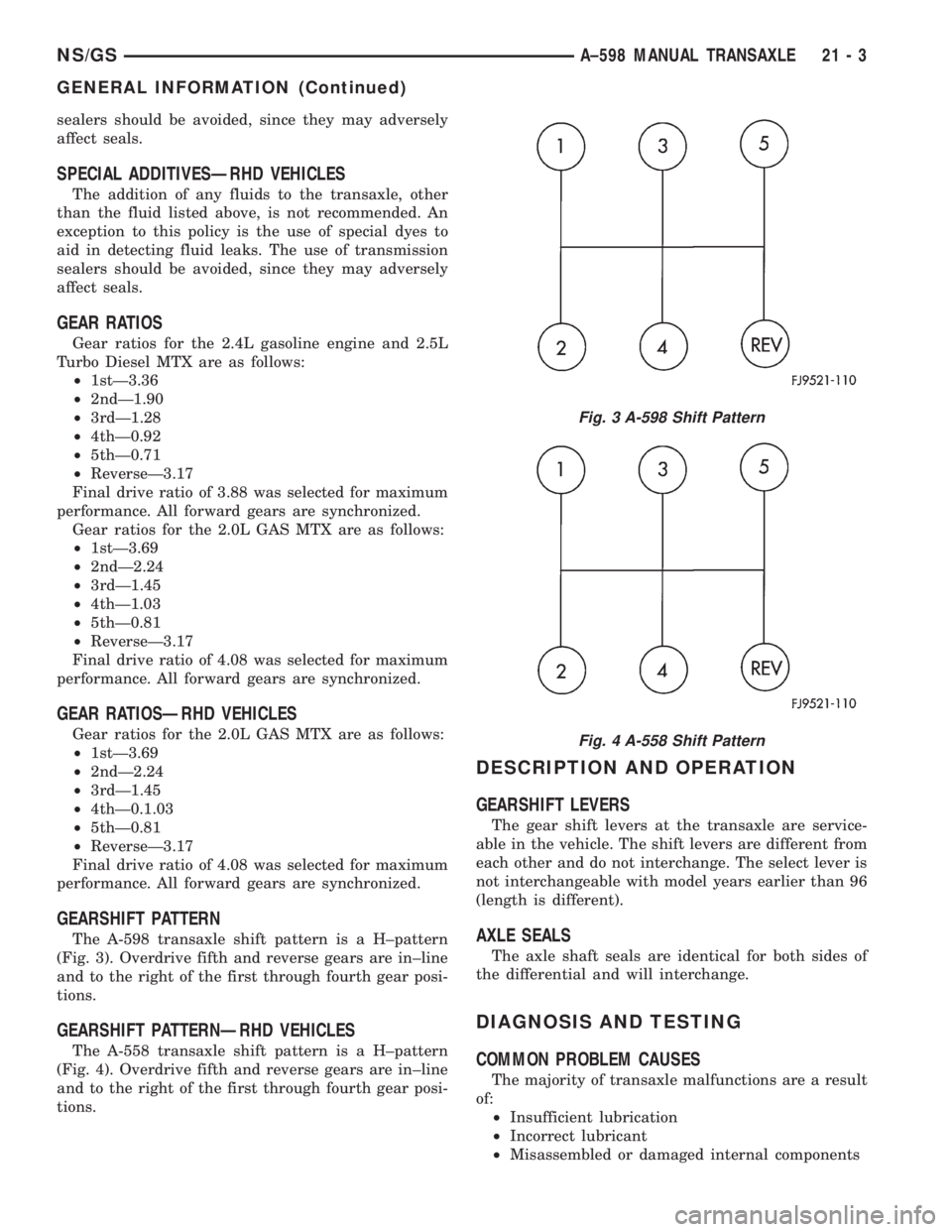
sealers should be avoided, since they may adversely
affect seals.
SPECIAL ADDITIVESÐRHD VEHICLES
The addition of any fluids to the transaxle, other
than the fluid listed above, is not recommended. An
exception to this policy is the use of special dyes to
aid in detecting fluid leaks. The use of transmission
sealers should be avoided, since they may adversely
affect seals.
GEAR RATIOS
Gear ratios for the 2.4L gasoline engine and 2.5L
Turbo Diesel MTX are as follows:
²1stÐ3.36
²2ndÐ1.90
²3rdÐ1.28
²4thÐ0.92
²5thÐ0.71
²ReverseÐ3.17
Final drive ratio of 3.88 was selected for maximum
performance. All forward gears are synchronized.
Gear ratios for the 2.0L GAS MTX are as follows:
²1stÐ3.69
²2ndÐ2.24
²3rdÐ1.45
²4thÐ1.03
²5thÐ0.81
²ReverseÐ3.17
Final drive ratio of 4.08 was selected for maximum
performance. All forward gears are synchronized.
GEAR RATIOSÐRHD VEHICLES
Gear ratios for the 2.0L GAS MTX are as follows:
²1stÐ3.69
²2ndÐ2.24
²3rdÐ1.45
²4thÐ0.1.03
²5thÐ0.81
²ReverseÐ3.17
Final drive ratio of 4.08 was selected for maximum
performance. All forward gears are synchronized.
GEARSHIFT PATTERN
The A-598 transaxle shift pattern is a H±pattern
(Fig. 3). Overdrive fifth and reverse gears are in±line
and to the right of the first through fourth gear posi-
tions.
GEARSHIFT PATTERNÐRHD VEHICLES
The A-558 transaxle shift pattern is a H±pattern
(Fig. 4). Overdrive fifth and reverse gears are in±line
and to the right of the first through fourth gear posi-
tions.
DESCRIPTION AND OPERATION
GEARSHIFT LEVERS
The gear shift levers at the transaxle are service-
able in the vehicle. The shift levers are different from
each other and do not interchange. The select lever is
not interchangeable with model years earlier than 96
(length is different).
AXLE SEALS
The axle shaft seals are identical for both sides of
the differential and will interchange.
DIAGNOSIS AND TESTING
COMMON PROBLEM CAUSES
The majority of transaxle malfunctions are a result
of:
²Insufficient lubrication
²Incorrect lubricant
²Misassembled or damaged internal components
Fig. 3 A-598 Shift Pattern
Fig. 4 A-558 Shift Pattern
NS/GSA±598 MANUAL TRANSAXLE 21 - 3
GENERAL INFORMATION (Continued)
Page 1660 of 1938
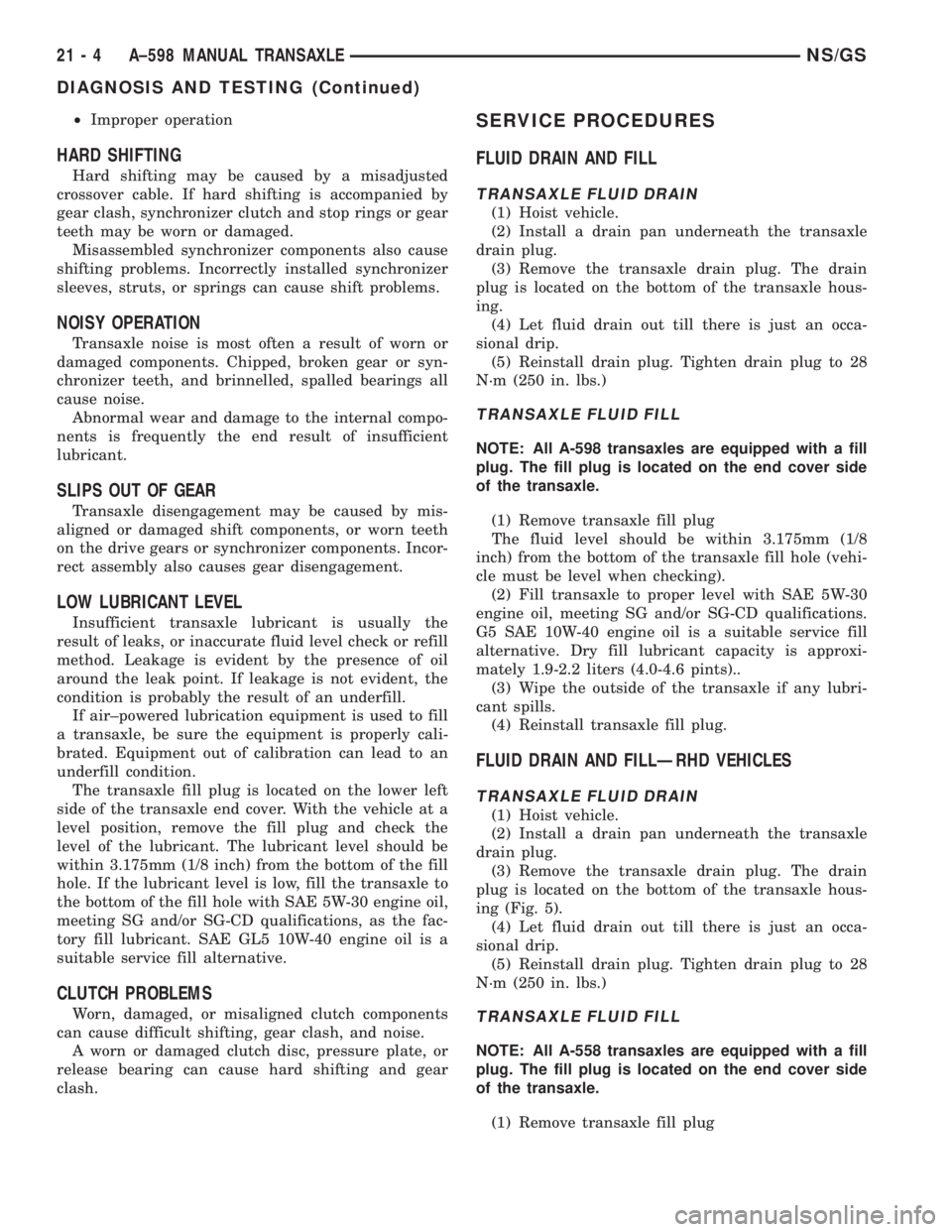
²Improper operation
HARD SHIFTING
Hard shifting may be caused by a misadjusted
crossover cable. If hard shifting is accompanied by
gear clash, synchronizer clutch and stop rings or gear
teeth may be worn or damaged.
Misassembled synchronizer components also cause
shifting problems. Incorrectly installed synchronizer
sleeves, struts, or springs can cause shift problems.
NOISY OPERATION
Transaxle noise is most often a result of worn or
damaged components. Chipped, broken gear or syn-
chronizer teeth, and brinnelled, spalled bearings all
cause noise.
Abnormal wear and damage to the internal compo-
nents is frequently the end result of insufficient
lubricant.
SLIPS OUT OF GEAR
Transaxle disengagement may be caused by mis-
aligned or damaged shift components, or worn teeth
on the drive gears or synchronizer components. Incor-
rect assembly also causes gear disengagement.
LOW LUBRICANT LEVEL
Insufficient transaxle lubricant is usually the
result of leaks, or inaccurate fluid level check or refill
method. Leakage is evident by the presence of oil
around the leak point. If leakage is not evident, the
condition is probably the result of an underfill.
If air±powered lubrication equipment is used to fill
a transaxle, be sure the equipment is properly cali-
brated. Equipment out of calibration can lead to an
underfill condition.
The transaxle fill plug is located on the lower left
side of the transaxle end cover. With the vehicle at a
level position, remove the fill plug and check the
level of the lubricant. The lubricant level should be
within 3.175mm (1/8 inch) from the bottom of the fill
hole. If the lubricant level is low, fill the transaxle to
the bottom of the fill hole with SAE 5W-30 engine oil,
meeting SG and/or SG-CD qualifications, as the fac-
tory fill lubricant. SAE GL5 10W-40 engine oil is a
suitable service fill alternative.
CLUTCH PROBLEMS
Worn, damaged, or misaligned clutch components
can cause difficult shifting, gear clash, and noise.
A worn or damaged clutch disc, pressure plate, or
release bearing can cause hard shifting and gear
clash.
SERVICE PROCEDURES
FLUID DRAIN AND FILL
TRANSAXLE FLUID DRAIN
(1) Hoist vehicle.
(2) Install a drain pan underneath the transaxle
drain plug.
(3) Remove the transaxle drain plug. The drain
plug is located on the bottom of the transaxle hous-
ing.
(4) Let fluid drain out till there is just an occa-
sional drip.
(5) Reinstall drain plug. Tighten drain plug to 28
N´m (250 in. lbs.)
TRANSAXLE FLUID FILL
NOTE: All A-598 transaxles are equipped with a fill
plug. The fill plug is located on the end cover side
of the transaxle.
(1) Remove transaxle fill plug
The fluid level should be within 3.175mm (1/8
inch) from the bottom of the transaxle fill hole (vehi-
cle must be level when checking).
(2) Fill transaxle to proper level with SAE 5W-30
engine oil, meeting SG and/or SG-CD qualifications.
G5 SAE 10W-40 engine oil is a suitable service fill
alternative. Dry fill lubricant capacity is approxi-
mately 1.9-2.2 liters (4.0-4.6 pints)..
(3) Wipe the outside of the transaxle if any lubri-
cant spills.
(4) Reinstall transaxle fill plug.
FLUID DRAIN AND FILLÐRHD VEHICLES
TRANSAXLE FLUID DRAIN
(1) Hoist vehicle.
(2) Install a drain pan underneath the transaxle
drain plug.
(3) Remove the transaxle drain plug. The drain
plug is located on the bottom of the transaxle hous-
ing (Fig. 5).
(4) Let fluid drain out till there is just an occa-
sional drip.
(5) Reinstall drain plug. Tighten drain plug to 28
N´m (250 in. lbs.)
TRANSAXLE FLUID FILL
NOTE: All A-558 transaxles are equipped with a fill
plug. The fill plug is located on the end cover side
of the transaxle.
(1) Remove transaxle fill plug
21 - 4 A±598 MANUAL TRANSAXLENS/GS
DIAGNOSIS AND TESTING (Continued)